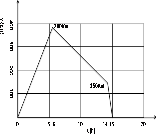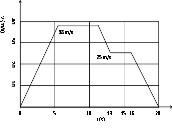Question – 1
1. Which atomic orbital has a value of n=4 and l=2?
- A. 5s
- B. 4p
- C. 4d
- D. 3f
- E. 4s
- Answer:C
- Answer Explanation:The principal quantum number indicates the position of the shell and orbital quantum number shows the 3D shape of the orbital, where l=2 corresponds to the d-orbital.
Question – 2
2. Which of the following sugars is an example for tetrose?
- A. Glucose
- B. Ribose
- C. Erythrose
- D. Threose
- E. Both c and d
- Answer:E
- Answer Explanation:Erythrose and Threose are monosaccharides that contain four carbon atoms and hence they are examples for tetrose. Glucose is a hexose, which contains six carbon atoms, and ribose is a pentose which contains five carbon atoms.
Question – 3
3. Consider the graph for displacement-time given below. The velocity and direction of travel between 6 h and 14 h is 
- A. 20 Km/h and forward.
- B. 25 Km/h and backward
- C. -28.75 Km/h and forward.
- D. -28.75 Km/h and backward.
- E. 28.75 Km/h and forward.
- Answer:D
- Answer Explanation:Velocity is defined as rate of change of displacement with respect to time or slope of displacement-time graph. ThereforeVelocity =
———(1)is the change in displacement = y2 – y1
is the change in displacement = t2 – t1y2 = 150Kmy1 = 380 Kmt2 = 14ht2 = 6hPut the values in the equation1.Velocity =
Velocity =
Or, Velocity = -28.75 Km/hHence, velocity between 6 h and 14 h is -28.75Km/h and negative slope between 6 h to 14 h signifies that the body is travelling in the backward direction. Therefore, option d is the correct answer as it gives the same velocity and direction.
Question – 4
4. Which of the following amino acids does not contain aliphatic side chains?
- A. Alanine
- B. Leucine
- C. Valine
- D. Tyrosine
- E. Isoleucine
- Answer:D
- Answer Explanation:Among the given amino acids tyrosine is the one which has aromatic side chain. Rest of the amino acids (Alanine, valine, leucine and isoleucine) have aliphatic side chains with carbon and hydrogen.
Question – 5
5. Calculate the number of molecules in 43 g of ammonia.
- A. 5.71 x 1022 molecules
- B. 11.12 x 1023 molecules
- C. 13.51 x 1023 molecules
- D. 15.21 x 1023 molecules
- E. 17.31 x 1022 molecules
- Answer:D
- Answer Explanation:One mole of a sample contains Avogadro number of molecules. To find out the number of molecules in a sample, first convert the gram of ammonia to mole, then covert the moles into number of molecule.One mole of ammonia = 17.03 g of ammonia43 g of ammonia = 43 g x (1 mol/17.03 g of ammonia) = 2.53 mol Therefore, 2.53 mole of ammonia contains,2.53 mol x (6.023 x 1023 molecules/1 mole) = 15.21 x 1023 molecules of ammonia.
Question – 6
6. If a body was at rest initially and acceleration of the body is dependent on displacement asa = ???S, Wherea is the acceleration of the bodyS is the displacement of the bodyThen the velocity-displacement equation can be written as
- A. v = S3/2
- B. v2 = S3
- C. v2 = S2
- D. v2 = S3/2
- E. v2 = 2S3/2
- Answer:E
- Answer Explanation:According to kinematic equation of motion v2 = u2 + 2aSWherev is the final velocity;u is the initial velocity;a is the acceleration of the bodyS is the displacement;Since, a = ???S and u = 0 m/s putting the values in the above equation we getv2 = 02 + 2.???S.SOr, v2 = 2S3/2Therefore, e is the correct answer.
Question – 7
7. The undifferentiated tissue in plants is known as
- A. Xylem
- B. Phloem
- C. Meristem
- D. Stem cells
- E. Protoderm
- Answer:B
- Answer Explanation:Meristematic cells are undifferentiated cells which are capable of differentiating into distinct cell types with distinct function in plants. Stem cells have the same function but in animals. Protoderm, xylem and phloem are differentiated tissues.
Question – 8
8. A tennis ball is projected upwards with an initial velocity if 9.8 m/s. What will be its velocity at 3/4th of the maximum height?
- A. 4 m/s
- B. 4.9 m/s
- C. 9.8 m/s
- D. 3.675 m/s
- E. 0
- Answer:B
- Answer Explanation:According to kinematic equation of motion,v2 = u2 – 2aS (Negative sign is used here because direction of acceleration is opposite to that body’s motion)Where,v is the final velocity;u is the initial velocity;a is the acceleration of the body;S is the displacement;We will first solve for the maximum height. At maximum height final velocity becomes zero and body tends to fall down.u=9.8 m/sv=0 m/sa = g = 9.8 m/s2 (Since body is projected upwards only acceleration it will experience is acceleration due to gravity (g)) Putting the values in the above equation we get
Therefore, the maximum height is 4.9 meters. We need to find velocity at 3/4th of the maximum height S=3/4 of the maximum heightS=3/4 x 4.9 mS=3.675mTherefore, by usingwe can find the velocity v
v=4.9 m/sTherefore, b is the correct answer.
Question – 9
9. The number of atoms per unit cell in bcc
- A. 1
- B. 2
- C. 3
- D. 4
- E. 5
- Answer:B
- Answer Explanation:In a bcc lattice, the body centered atom belongs exclusively to the unit cell and the atom in the corner shared by eight unit cell. Thus the total number of atoms per unit cell in bcc = (Nc/8) + (Nb/1) = (8/8) + (1/1) = 2Nc = number of atoms at the corners and Nb = number of atoms inside the body.
Question – 10
10. How many major classes of enzymes are there?
- A. 5
- B. 7
- C. 6
- D. 4
- E. 8
- Answer:C
- Answer Explanation:The six major classes of enzymes are oxidoreductase (catalyses oxidation and reduction reaction), transferase (catalyses group transfer reactions), hydrolase (catalyses breakage of bondby addition of water), lyase (catalyses cleavage of bonds other than by hydrolysis), isomerase(catalysesrearrangement of existing atoms of a molecule) and ligase (catalyses formation of bonds).
Question – 11
11. Which of the following is not a projectile?
- A. A missile fired from a rocket
- B. A baseball that has been thrown
- C. An object being dropped from rest
- D. An object being fired at some angle from the horizontal
- E. A man walking on the floor
- Answer:E
- Answer Explanation:Projectile is a name given to the object upon which only force of gravity acts. A projectile always follows a parabolic path during its flight. Since, man walking cannot follow a parabolic path hence it is not a projectile. All the other options refer to projectiles and hence, e is the correct answer option.
Question – 12
12. Which of the following organelles takes part in protein glycosylation?
- A. Nucleus
- B. Mitochondria
- C. Centriole
- D. Endoplasmic reticulum
- E. Lysosomes
- Answer:D
- Answer Explanation:Endoplasmic reticulum is the organelle responsible for glycosylation of proteins. Protein glycosylation is an enzyme directed post translational modification. Glycosylation is a site specific modification and is non-templated.
Question – 13
13. The freezing point of a 0.01 m aqueous solution of NaCl will be
- A. 00C
- B. Below00C
- C. 10C
- D. 20C
- E. 2.50C
- Answer:B
- Answer Explanation:There is always change (depression) in the freezing point by the addition of solute to a solvent. Therefore, the freezing point of NaCl solution will be lower than that of water. Water’s freezing point is zero degree.
Question – 14
14. Consider the velocity-time graph given below. What is the acceleration between 13 and 16 seconds?
- A. 0
- B. 6.5 m/s2
- C. -6.5 m/s2
- D. 6.33 m/s2
- E. 5 m/s2
- Answer:A
- Answer Explanation:Acceleration is rate of change of velocity with respect to time. Henceacceleration,
Since, there is no change in velocity between 13 and 16 seconds so,=0. Hence, acceleration becomes zero. A body does not accelerate if it is moving with constant velocity. Therefore, a is the correct answer option.
Question – 15
15. Which of the following is the cloning vector?
- A. Plasmid
- B. Cosmids
- C. BAC
- D. YAC
- E. All the above
- Answer:E
- Answer Explanation:Cloning vectors are DNA molecules that carry foreign DNA into host cells. That cloning vectors replicate inside the bacteria or yeast cell and produce many copies. Plasmid, cosmids, bacterial artificial chromosomes (BAC) and yeast artificial chromosomes (YAC) are used as vectors.